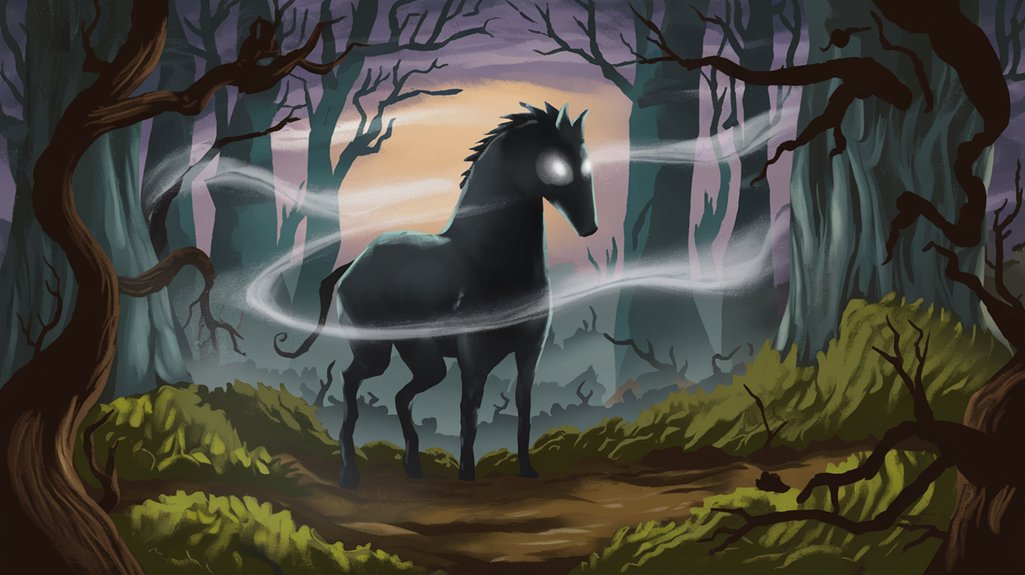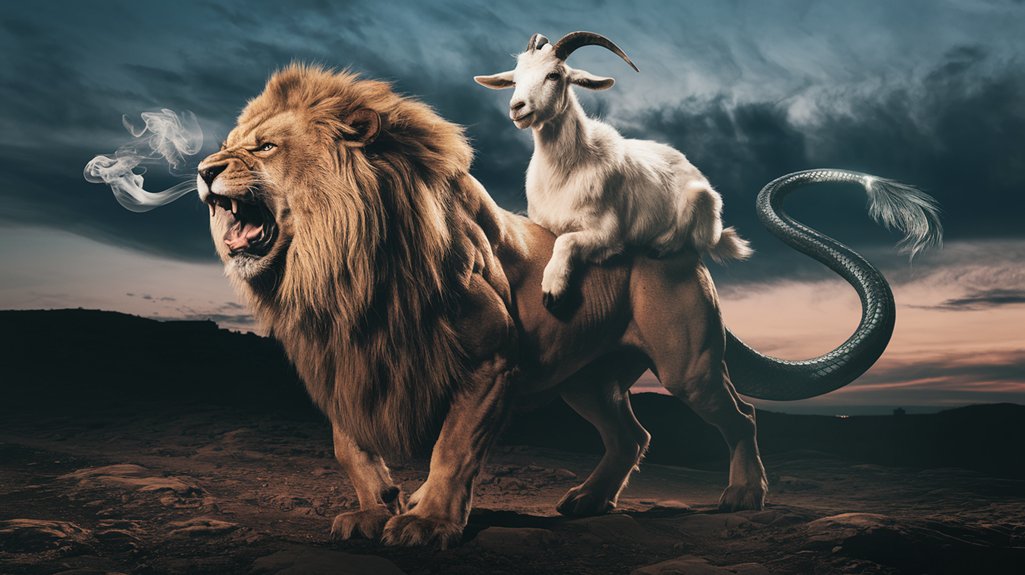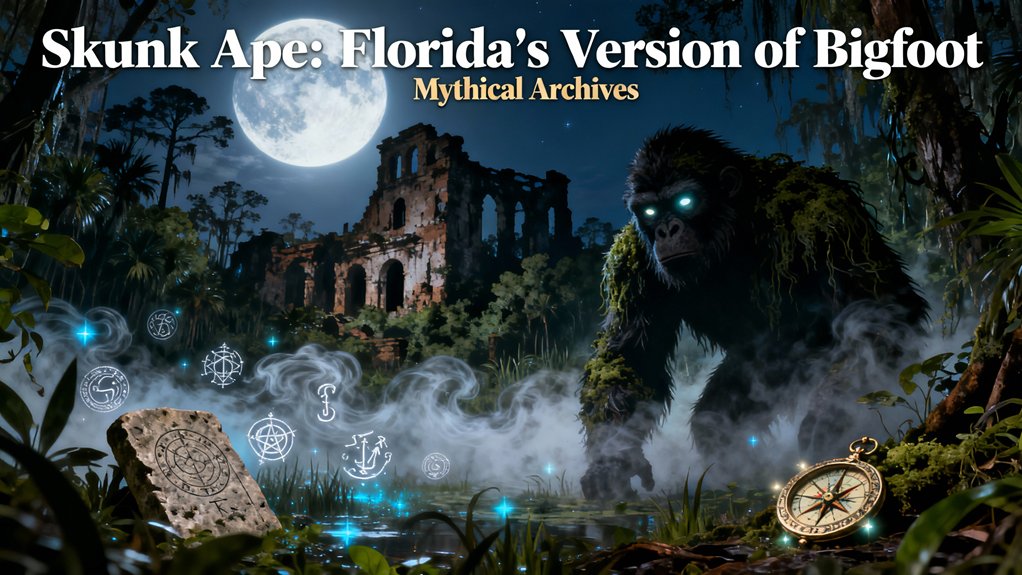
You’ll encounter Florida’s Skunk Ape in the Everglades’ liminal territories—a seven-foot hominid distinguished by reddish-brown fur and sulfurous stench that predates modern sightings to Seminole oral traditions. Since 1974’s surge in Collier County encounters, witnesses have documented its chimeric features: stooped posture, fourteen-to-eighteen-inch footprints, crimson-reflecting eyes, and that signature odor blending rotten eggs with decaying vegetation. The famous 2000 Myakka photographs captured impossibly elongated arms, while Dave Shealy’s Research Headquarters preserves documented vocalizations and track casts. Beyond scientific skepticism lie deeper mysteries connecting ancient knowledge to contemporary testimony.
Table of Contents
ToggleKey Takeaways
- The Skunk Ape is a seven-foot hairy hominid reported in Florida’s swamps since the 1960s, similar to Bigfoot legends.
- Named for its overwhelming sulfurous stench resembling rotten eggs and skunk spray that precedes sightings by several minutes.
- Famous evidence includes the 2000 Myakka photographs showing a simian figure with elongated arms in the Everglades.
- Sightings concentrate in Big Cypress National Preserve’s 729,000 acres of wetlands, where ecosystems merge creating ideal habitat.
- Generates $2.3 million annually in tourism revenue with ongoing research at the dedicated Skunk Ape Research Headquarters.
The Origins and History of Skunk Ape Sightings

While the Skunk Ape emerged into popular consciousness during the 1960s and 1970s—when Florida’s swamplands yielded their first documented encounters—the creature’s roots extend far deeper into the peninsula’s antediluvian past.
You’ll discover that indigenous Seminole peoples preserved oral traditions describing eldritch beings inhabiting the Everglades’ liminal territories, entities that predate colonial intrusion by centuries. These swamp legends spoke of chimeric guardians traversing brackish waters under moonless skies.
The modern cryptid folklore crystallized in 1974, when documented reports surged throughout Collier County. Witnesses described a seven-foot hominid emanating putrid odors, leaving inexplicable tracks across muck and sawgrass.
Freedom-seekers venturing beyond civilization’s boundaries returned with accounts that defied rational categorization.
Ancient knowledge converges with contemporary testimony here. You’re examining not mere folklore but a persistent phenomenological tradition—one suggesting that Florida’s primordial wilderness harbors mysteries that resist domestication, entities that embody the untamed sovereignty you seek beyond societal constraints.
Physical Characteristics and Notable Features
Eyewitness accounts converge on distinctive physiological markers that separate the Skunk Ape from its cryptid cousins across North America’s wilderness corridors.
You’ll find descriptions emphasizing a hairy physique cloaked in reddish-brown or black fur, matted with swamp detritus and emanating that signature sulfurous odor—hence its evocative name. Standing between six and seven feet tall, this chimeric entity leaves large footprints measuring fourteen to eighteen inches, pressed deep into Florida’s sodden earth.
Reddish-brown fur matted with swamp debris, sulfurous stench permeating the air, and massive footprints sinking into Florida’s waterlogged soil.
The creature’s morphology defies easy classification. Witnesses describe a stooped posture, simian features, elongated arms. Eyes that reflect crimson in flashlight beams.
That smell—rotting eggs, decaying vegetation, methane rising from ancient peat—marks its territory with eldritch certainty. You’re confronting something that belongs to the liminal spaces between known zoology and folklore’s darker margins.
The Skunk Ape exists where cypress shadows deepen, where your scientific certainty dissolves into primal unease, where freedom means accepting mysteries that resist categorization.
The Signature Smell: Why “Skunk Ape”?
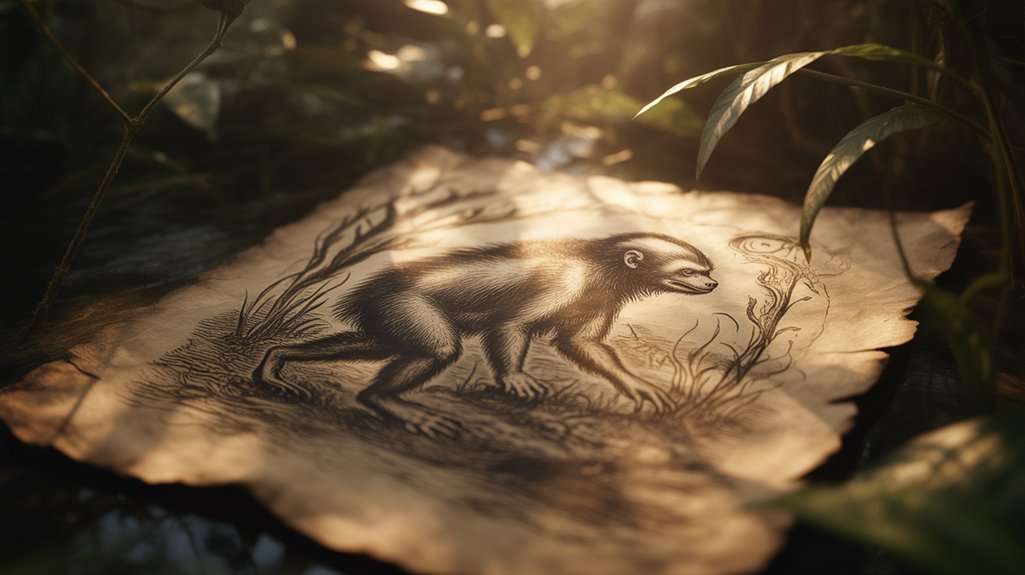
You can’t comprehend the Skunk Ape’s most eldritch characteristic—its overwhelming stench—without examining the countless witness testimonies that speak, with remarkable consistency, of an odor so pungent it precedes the creature’s physical manifestation by several minutes.
Eyewitnesses across the Everglades region, from the 1960s encounters near Big Cypress Swamp to contemporary sightings in Myakka River State Park, describe a sulfurous, putrid amalgamation: rotting eggs meeting skunk spray, decaying vegetation mingling with unwashed fur, a chimeric assault upon the olfactory senses that lingers long after the creature vanishes into the palmetto thickets.
Cryptozoologists propose theories ranging from apocrine gland secretions used for territorial marking to the accumulation of swamp detritus in matted hair, yet the stench remains the creature’s most documented feature—its olfactory signature burned into memory.
Witness Descriptions of Odor
Something primal lurks within the olfactory testimony of those who claim encounters with Florida’s cryptid—a stench so overwhelming, so biologically aggressive, that it has etched itself into the creature’s very nomenclature.
Witness testimonials converge on remarkably consistent odor descriptions: rotten eggs sulfurous and sharp, decaying flesh mingled with marsh gases, skunk musk amplified beyond natural proportions.
You’ll find accounts from the 1960s Everglades expeditions documenting this eldritch characteristic, describing an assault upon human senses that triggers flight responses.
The chimeric quality persists—simultaneously animal and otherworldly. This isn’t mere swamp rot.
Witnesses report the smell clinging to clothing for days, penetrating enclosed vehicles, announcing the creature’s presence before visual contact.
The reek becomes territorial marker, warning, identity itself.
Comparing Smells to Skunks
While the common striped skunk (*Mephitis mephitis*) deploys its defensive spray as measured chemical warfare—thiols and sulfur compounds calibrated by evolution to repel predators at distances up to fifteen feet—witnesses describe the Skunk Ape’s emanation as categorically more visceral, more persistent, more biologically aberrant.
You’ll find that skunk comparisons prove inadequate upon deeper odor analysis. The creature’s signature reek suggests not territorial defense but ontological wrongness—something chimeric, something eldritch dwelling in swamp-time where decay ferments into its own peculiar genesis.
Traditional skunk musk dissipates within hours. The Skunk Ape’s presence lingers for days, saturating clothes, embedding itself in memory like ancient trauma.
Seminole oral histories reference this olfactory assault predating European contact. Not defensive chemistry. Something else entirely. Primal wrongness made manifest through scent.
Theories Behind the Stench
Because conventional cryptozoological analysis demands empirical frameworks, researchers have proposed three competing hypotheses to explain the Skunk Ape’s notorious stench: the dietary-metabolic theory, the territorial-glandular theory, and the interdimensional-miasmatic theory.
You’ll find the dietary-metabolic approach suggests fermenting vegetation generates sulfurous compounds through gut bacteria. The territorial-glandular theory posits specialized apocrine glands marking boundaries, similar to mustelids.
Most controversial remains the interdimensional-miasmatic theory, wherein the creature’s eldritch nature produces chimeric odor signatures defying conventional odor analysis.
Stench origins may ultimately transcend materialist frameworks. Ancient Seminole accounts describe beings emerging from swamp portals, trailing “spirit-smoke.”
You’re confronting something that bridges worlds, leaving olfactory evidence science can’t fully categorize. The mystery deepens when you consider freedom from academic dogma reveals truths institutional research dismisses.
Famous Encounters and Documented Evidence

You encounter the phenomenon’s most compelling traces in two distinct evidentiary strands: the enigmatic Myakka photographs of 2000, wherein an anonymous correspondent transmitted images of a simian entity lurking amid palmettos, its eyes reflecting camera flash with an eldritch luminescence that defied conventional zoological classification.
Dave Shealy emerges as the creature’s most persistent chronicler, documenting multiple encounters within the Everglades’ liminal wetlands since 1974, his testimonies accumulating like sedimentary layers of folkloric truth.
These accounts transcend mere anecdote—they constitute a fragmentary archive of the ineffable, each sighting adding texture to Florida’s cryptozoological tapestry.
The Myakka Photographs Mystery
Among the most compelling cryptozoological evidence to emerge from Florida’s wilderness arrived anonymously in December 2000, when a Sarasota County sheriff’s office received two Polaroid photographs accompanied by a cryptic letter.
These images captured something primal, eldritch—a hulking figure crouched behind palmettos, eyes reflecting the camera flash with an otherworldly luminescence.
You’ll find yourself drawn into photograph analysis that reveals dense, matted fur, impossibly long arms, and pronounced brow ridges suggesting something chimeric, neither wholly ape nor entirely unknown.
The Myakka sightings preceded these photographs by decades, yet this evidence crystallized folklore into tangible possibility.
Forensic experts debated authenticity for years. The sender’s identity remains concealed, preserved within liminal mystery.
You’re left confronting uncomfortable questions about what stalks Florida’s swamplands after darkness falls.
Dave Shealy’s Multiple Sightings
Deep within Big Cypress National Preserve, where ancient cypress knees pierce black water and Spanish moss hangs like tattered shrouds, Dave Shealy has changed himself from Everglades guide into Florida’s preeminent Skunk Ape chronicler through a series of encounters spanning three decades.
His eyewitness accounts, documented across multiple sighting locations, include:
- 1974 initial encounter – Age ten, observing a seven-foot bipedal entity near Turner River
- 2000 video capture – Thermal footage revealing chimeric movement patterns through palmetto thickets
- 2004 daylight observation – Sustained visual contact lasting forty-seven seconds
- Ongoing territory monitoring – Establishing the Skunk Ape Research Headquarters, cataloging vocalizations and track casts
You’ll find his testimonies bear eldritch consistency.
Each documentation adds empirical weight to Florida’s cryptozoological heritage.
Prime Skunk Ape Territory in Florida
When cartographers first charted the primordial wetlands of South Florida in the 1840s, they marked vast stretches as “terra incognita”—unknown lands where conventional mapping ceased to hold meaning.
You’ll find these same territories harbor today’s most compelling Skunk Ape encounters: the sawgrass prairies, cypress domes, and mangrove tunnels where civilization’s grip loosens.
Big Cypress National Preserve stands paramount. Here, 729,000 acres of limestone substrate, hardwood hammocks, and seasonal flooding create an eldritch sanctuary. The creature thrives where human presence remains transient, ephemeral.
In these 729,000 acres of primordial wilderness, the Skunk Ape finds refuge where human footsteps fade into memory.
Everglades Exploration reveals consistent patterns—sightings cluster along ecotones, those liminal zones where ecosystems merge.
The Turner River, Fakahatchee Strand, and Loop Road corridor form a chimeric landscape, neither fully aquatic nor terrestrial. Dense vegetation obscures sight lines beyond thirty feet. The humidity carries scent for miles.
You’re entering territory mapped not by roads but by ancient cypress sentinels, their knees jutting from black water like monuments to forgotten epochs.
Scientific Explanations and Skeptical Theories
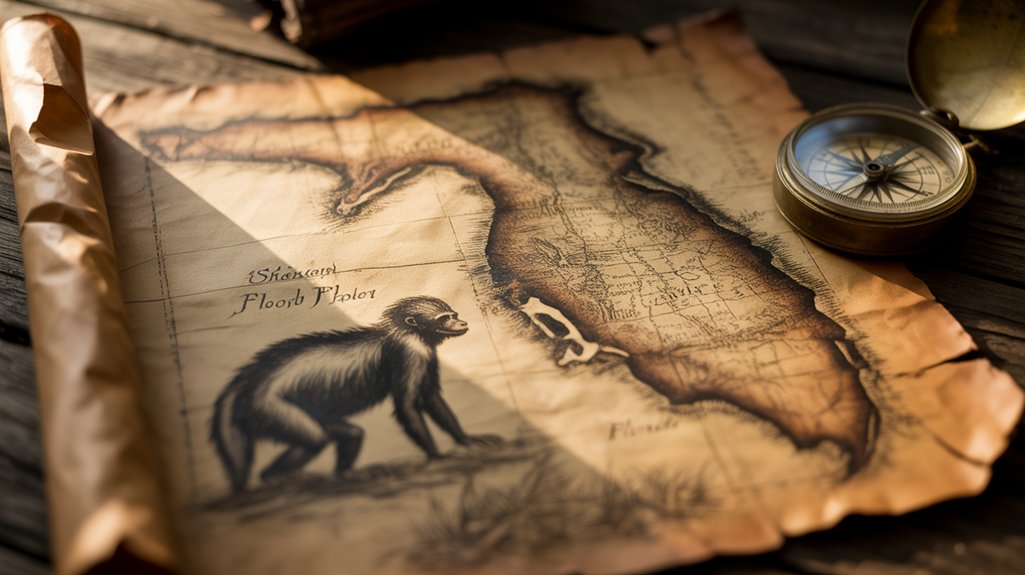
While cryptozoologists catalog footprint casts and thermal signatures, mainstream science offers terrestrial explanations rooted in misidentification and cognitive bias.
Scientific skepticism presents these alternative explanations:
- Ursus americanus floridanus—the Florida black bear—whose bipedal posture during foraging creates chimeric silhouettes in twilight’s eldritch hour, particularly when adolescents exhibit mange-ravaged pelts.
- Pareidolia phenomena, where human neural architecture alters palmetto shadows and cypress knees into anthropoid forms, ancient survival mechanisms misfiring within swamp’s liminal threshold.
- Escaped primates from roadside attractions, their presence documented since 1930s tourism boom, wandering Everglades periphery as feral expatriates.
- Collective mythos-building, where cultural narratives, Seminole traditions, and frontier isolation coalesce into persistent folk taxonomy.
You’ll discover that scientific skepticism doesn’t diminish wonder. Rather, it illuminates how wilderness—that sacred space between known and unknown—generates genuine mysteries through psychological and biological mechanisms.
The swamp remains numinous whether harboring cryptid or cognitive shadow.
The Cultural Impact and Ongoing Search
The Skunk Ape has transcended cryptozoological curiosity to become Florida’s unofficial ambassador of the strange, generating estimated $2.3 million annually through tourism revenue across Collier and Hendry counties alone. Its cultural significance permeates regional identity, manifesting through roadside attractions, documentary expeditions, and folklore festivals that honor this eldritch presence dwelling within palmetto thickets and cypress domes.
You’ll find the creature’s media portrayal oscillating between chimeric monster and misunderstood forest guardian, each interpretation revealing humanity’s relationship with wilderness itself.
| Cultural Element | Impact |
|---|---|
| Local Museums | Skunk Ape Research Headquarters established 2000 |
| Film/Television | 47 documented appearances across media formats |
| Annual Expeditions | 200+ organized searches conducted since 1997 |
Modern seekers continue their vigil, armed with thermal imaging and tradition alike. The search persists not merely for physical evidence but for connection to something primordial, untamed. Florida’s swamps guard their secrets still.
Frequently Asked Questions
How Does the Skunk Ape Compare to Other Cryptids Like Sasquatch?
You’ll find skunk ape characteristics align remarkably with sasquatch similarities—both manifest as towering, bipedal hominids cloaked in matted hair, dwelling in liminal wilderness spaces.
Yet Florida’s cryptid distinguishes itself through its notorious, sulfurous reek, smaller stature averaging seven feet, and preference for subtropical swamplands rather than Pacific Northwest forests.
The sasquatch embodies eldritch mountain mystery; the skunk ape haunts fetid wetlands, a chimeric guardian of Southern marshes, both resisting classification within conventional zoological frameworks.
Are There Any Laws Protecting the Skunk Ape in Florida?
You’ll find no official skunk ape protection—straight from the horse’s mouth, Florida wildlife regulations don’t recognize cryptids.
However, you’re free to explore this legal void where governmental authority hasn’t trampled the chimeric mystery. The eldritch creature dwells beyond bureaucratic reach, unbound by conservation statutes designed for documented species.
This absence of legal constraint paradoxically preserves its liminal status, allowing you to pursue evidence without regulatory interference. The swamp-dwelling entity remains sovereign, untouched by legislative hands that would catalog, control, or constrain its enigmatic existence.
What Should I Do if I Encounter a Skunk Ape?
Should you encounter this eldritch creature in Florida’s primordial wetlands, observe essential safety precautions: maintain respectful distance, avoid direct eye contact, and retreat slowly without turning your back.
These encounter tips honor ancient protocols for confronting chimeric beings. Don’t photograph or provoke the entity; such intrusions violate sacred boundaries between worlds.
Trust your instincts—that primal recognition coursing through your veins. Document details later, preserving the mystical threshold you’ve crossed while ensuring your sovereign departure from its domain.
Has Anyone Ever Tried to Capture a Skunk Ape Alive?
Like Ahab pursuing his white whale, numerous cryptozoologists have launched capture attempts since the 1970s, seeking to bind this eldritch creature.
You’ll find documented skunk ape sightings escalating throughout Florida’s Everglades, yet the chimeric beast remains unconstrained—perhaps intentionally.
No cage has held it, no tracker has successfully ensnared it. The swamp whispers that some mysteries demand freedom, that ancient beings resist human dominion.
Your pursuit may reveal more about yourself than the quarry you seek.
Do Local Native American Tribes Have Legends About the Skunk Ape?
You’ll discover profound tribal folklore among the Seminole and Miccosukee peoples, who speak of the “Esti Capcaki”—a towering, eldritch guardian dwelling in cypress swamps.
These ancient narratives predate Western contact, imbuing the creature with cultural significance as boundary-keeper between worlds. The chimeric being wasn’t feared but revered, a manifestation of wilderness itself.
Such oral traditions, preserved through generations, suggest your modern Skunk Ape encounters echo something far older, something that walks the liminal threshold between myth and flesh.
Conclusion
You stand at the threshold between cypress shadow and empirical truth, where the skunk ape exists as chimeric cipher—neither wholly corporeal nor entirely phantasmal. This eldritch guardian of the Everglades transcends mere cryptozoological classification, embodying Florida’s untamed essence, its sulphurous musk a warning: some mysteries resist domestication. Whether you’re skeptic or believer, you’ve glimpsed something profound—the swamp’s refusal to surrender all its secrets to scientific scrutiny.




